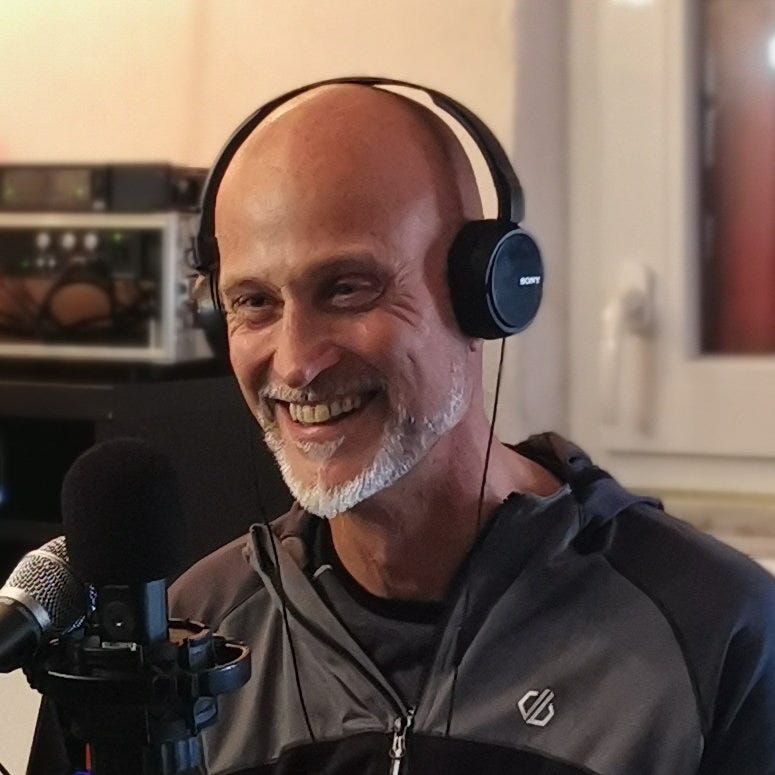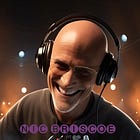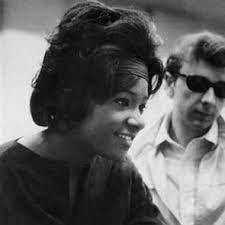🎵Tune Tag #3 with Nic Briscoe of "The Song's the Thing": Bowie, Deep Purple, Pink Floyd, Cher
It's the magical musical game of Tune Tag, where one song leads to another, with surprising twists and turns in style, era, and genre! Join the fun!
TAG! You’re it, Nic! Today, we’re Tune Taggin’ with singer/songwriter/guitar player/author, Nic Briscoe of Substack’s “The Song’s the Thing”! You can learn more about Nic, his songs, books, and more, on his website, clickable here!

TUNE TAG: Ideally, each track we send the other will have some tie-in with the one we were previously sent! Whether thematically or musically, the challenge is to pick a common element for a song to send to the other player.
Please note: The comments written by each Tune Tag player are written in real time, before each see the comments from the other! In other words, Nic won’t see my comments until this is published (and, I only saw his after I had written mine)!
Play along with Nic and me, if you’d like (which song would you follow with? Leave us a comment!), and consider playing Tune Tag with a friend, in real life, or virtually!
Here’s Nic’s Tune Tag, Part 2, completed in early February 2024. Enjoy!👇
Nic #1 (sent to Brad): “Under Pressure,” Queen and David Bowie, 1981
The final three selections in Brad’s previous Tune Tag with Andy were cover versions of Beatles songs, one by an Italian band, the other two by US singers, and one whose descent is Honduran, Spanish (specifically Basque), Danish, Irish, and German.
I wanted to somehow link to a very English pop song, which could claim similar if not an even more direct kind of multinational descent.
“Under Pressure” by Queen and David Bowie (produced by Bowie and Queen) fits the bill. It went directly to #1 in the UK Singles Chart (and #29 in the U.S. Billboard Hot 100). Here’s a brief, but fascinating interview/how-they-made-it video:
For me a key fact is that Bowie and Mercury never got to perform the song live together.
Bowie remembers making “Under Pressure”:
Brad’s response to Nic’s #1:
I immediately thought Bowie duet. With the first song in a Tune Tag, it can be tough to latch onto “a theme”: The field is wide open. While the temptation was strong to hunt down artists born in Zanzibar (as Freddie Mercury was), I figured that might end up being something of a fool’s errand.
Bowie recorded (and performed, but not always on record) many duets. We covered his legendary TV Christmas duet with Bing Crosby, here (Bowie briefly references Bing in the above video!):
I found a couple of Bowie duets, but decided on one I’d never seen before (and was never recorded…hurray for ‘70s TV variety shows!). It’s a song from his Young Americans album.
From Rolling Stone: “1975 was a dark year for Bowie, who spent much of the year binging on cocaine and exploring the occult while recording Station to Station. But, he made time for a surprisingly family-friendly appearance on Cher’s CBS variety show” [recorded at CBS-TV’s Beverly Boulevard Studios in Los Angeles].
From Nacho Video, the YouTube creator on whose page this video appears: “Bowie claims to remember almost nothing of the recording of the show or of meeting Cher. This is consistent with his claims about the entire Station to Station/L.A. period where there was little sleep, and sustenance was mainly in powder form.
“Years later Bowie speculated, ‘I was probably this crazed anorexic figure walking in. I’m sure she didn’t know what to make of me’.
“The intro to my video is of course from the notorious ‘live by expensive satellite’ Russell Harty TV interview [aired in the UK]. Bowie was in ‘beautiful downtown Burbank, Los Angeles’ (about 10 miles from the Fairfax District, where The Cher Show was recorded) with Harty in London.”
It was this duet I decided to send Nic as my first tagged tune!
Brad #1 (sent to Nic): “Can You Hear Me?”-David Bowie & Cher (live TV performance 11/23/75 air)
BONUS: From this same show came this incredible, little-seen medley duet by the born-as David Robert Jones and Cherilyn Sarkisian, with these added notes by FR&B:
This duet (performed only this one time, and never recorded on record) is eye-opening and jaw-dropping on so many levels: Unbelievably, this Bowie/Cher medley sandwiches songs by The Crystals, Neil Diamond, Harry Nilsson, The 5th Dimension, The Platters, Bill Withers, The Beatles and more between “Young Americans” itself!
The obligatory production numbers on these long-gone variety shows have always been a source of fascination for me: The rehearsal time spent learning medley arrangements, alone, is mind-boggling…not to mention any dancing involved!
Historically amazing tidbit: Cher, here, sings a snippet (as nonchalant as you please!) of The Crystals’ “Da Doo Ron Ron” (written by Phil Spector, Ellie Greenwich, and Jeff Barry, and recorded by FR&B contributor/recording artist, Stephen Michael Schwartz in 1974) on which she sang backing vocals a dozen years before on the original Spector/Gold Star Studios recording!
Indeed, Dolores “LaLa” Brooks (shown above, with Spector) was the lead vocalist on the Crystals’ March 1963 recording. Brooks told the syndicated radio program, Solid Gold Weekend, that Cher was one of the singers backing her lead vocals (at age 16! Cher wouldn’t turn 17 for two more months!)
Sonny Bono (who’d marry Cher the following year), who was also a record producer at the time, and was hanging out at those Spector/Crystals sessions, recalls Spector asking if the song was “dumb enough,” meaning if it was accessible to the teenagers who were the target audience.
Spector knew he had a hit with this one, telling Bono on playback, “That’s solid gold coming out of that speaker.” That Bowie/Cher medley duet can be seen here:
Nic’s response to Brad’s #1:
In reply to “Under Pressure,” Brad sent me the 1974 Bowie song, “Can You Hear Me,” specifically a live duet with Cher from her show in 1975.
Well, that’s one of my favourite tracks from one of my favourite albums, Bowie’s Young Americans from 1975. Wherever this Tune Tag went next, it had to in some way be linked to young Americans.
I admire Cher, however, I’m not a big fan, apart from her 1966 hit, “Bang Bang (My Baby Shot Me Down).” Here’s a YouTube link to a live version, Cher with Glen Campbell [from Glen’s CBS-TV U.S. Goodtime Hour variety show, 1969. [Again, the rehearsal time needed to learn the new lyrics to accommodate, now, two singers!].
Cher’s version was probably eclipsed by Nancy Sinatra’s version, also a big hit in 1966. This version was brought roaring back into the zeitgeist in the 2003 Quentin Tarantino Kill Bill Vol. 1 motion picture.
So I needed a Tarantino film, set in the mid- to late-’60s, about young Americans… Once Upon a Time...in Hollywood: Set in 1969, definitely about young Americans. Now I needed a song from said movie, which had that Cher/Bowie US of A/British link..







